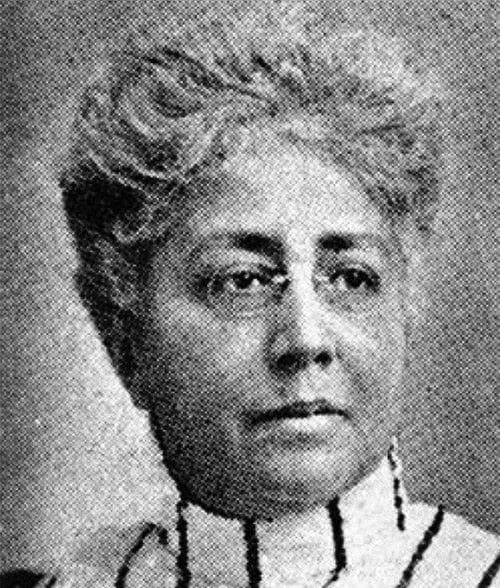Josephine St. Pierre Ruffin: A pioneer in the black women’s club movement
Part 2

This is Part 2, continuing on the February 4 article about Josephine St. Pierre Ruffin
The second day of the National Conference of Colored Women of America opened at 10:45 a.m. on July 30, 1895 with Josephine Ruffin chairing. A secret session opened to women only was held, at which the letter of John W. Jacks to Florence Balgarnie was discussed. After debating in closed session for three hours, the convention adopted resolutions denouncing Jacks “as a traducer of female character, a man wholly without a sense of chivalry and honor, bound by the iron hand of prejudice, sectionalism and race hatred, entirely unreliable and unworthy of the prominence he seeks.”
In the afternoon session, Margaret Murray Washington, wife of black leader Booker T. Washington and president of the Tuskegee Woman’s Club, read an influential paper on “Individual Work for Moral Elevation.” She divided black women into two classes: a class who “had the opportunity to improve and develop mentally, physically, morally, spiritually and financially,” and another who had been denied that opportunity due to enslavement. Washington said that the latter class, overwhelming in its numbers and mighty in its strength, could be lifted up, inspired, taught and sustained. She asked rhetorically, “Is there no bond between these two classes of the same race?” She insisted that a bond was essential, since the race did not make progress when individuals among it climbed the ladder in almost all of the avenues of life. It was the “lifting as we climb,” she said, which meant growth to the race.
On the third day of the conference, energy and enthusiasm abounded because a national organization was sought. Indeed, the consensus among the delegates was there should be a permanent national organization, but they could not agree on how to form one. Some suggested that the convention be merged into the National League of Colored Women, which gained its national character because it had representative organizations in a handful of states. Others recommended that the call of the Woman’s Era Club for a national conference of black women be the foundation upon which to form a national organization. These two positions were hotly debated until it became apparent that another day would be required before the matter could be settled.
An added session of the conference commenced on August 1 at 10 a.m. at the Charles Street AME Church. Florida Ruffin Ridley presented resolutions calling for the immediate formation of a national organization as the outgrowth of the convention and looking to a union on equal terms with the already existing National League of Colored Women. She argued, “We need the National League, and the National League needs us. I believe that we should form a distinct organization, elect our officers and confer with the National League. I believe that this body should have some distinct expression.”
Helen A. Cook countered, “It is not my purpose to become an advocate for the National League. I only want to impress upon your minds that our place is fixed by our organization. Now is a grand opportunity to complete a national organization.” Cook hoped that if they formed a separate organization, both would eventually merge into one.
At the conclusion of the debate, the resolutions were unanimously adopted, and a committee composed of one delegate from each delegation was appointed and charged with looking into the matter of organization. That afternoon, the committee reported back and recommended that a national organization be formed known as the National Federation of Afro-American Women (NFA-AW) and that a corps of officers suited to the needs of the federation be elected immediately.
Washington was elected president of the NFA-AW. The Boston Globe reported that she “was escorted to the platform amid the waving of handkerchiefs. She thanked the conference for electing her … and said that she would work for the best interests of the organization and try to make it a national success.” Vice presidents were chosen as well and Ruffin’s name was suggested as treasurer of the organization, but she declined to serve. It was agreed that the Woman’s Era would become the organ of the NFA-AW.
The delegates adopted a constitution and resolutions thanking the Woman’s Era Club and the people of Boston for their kindness during the conference. They also thanked the pastor and trustees of the Charles Street AME Church for the use of their house of worship during the closing session. Ruffin was presented with a large bouquet, as were the two secretaries of the conference.
Creation of the National Association of Colored Women
The National Federation of Afro-American Women met at the Nineteenth Street Baptist Church in Washington, D.C., from July 20 to July 22, 1896. On the second day of the conference, Washington delivered an address on the “Progress of Women,” and the balance of the morning session was devoted to a presentation of reports from the various women’s clubs and leagues. The afternoon and evening sessions were dedicated to the reading of papers. Among them were: “More Homes for Our Aged,” by Harriet Tubman, of Auburn, N.Y.; “Mountain Women of Virginia,” by Jennie S. Dean, of Manassas, Va.; “The Douglass Monument,” by R. Jerome Jeffrey, of Rochester, N.Y.; “Temperance,” by Lucy B. Thurman, of Jackson, Mich.; “Reform,” by Ida B. Wells Barnett, of Chicago; “The Separate Car System as It Affects the Dignity of Afro-American Womanhood,” by Lillian Thomas Fox, of Indianapolis, Ind., and “Prison Reform,” by Marie S. Foster, of Cambridge, Mass.
A joint committee, made up of seven members of the National League of Colored Women and seven members of the National Federation of Afro-American Women, was appointed and charged with looking into the matter of merging the two organizations. After conferring nearly the entire afternoon, the joint committee, chaired by Mary Church Terrell, presented a written agreement consolidating the two organizations. As a direct outcome of Terrell’s strong leadership and individual effort, as well as the efforts of Ruffin and others, the National Association of Colored Women (NACW) was born.
The joint committee also agreed to draft a constitution and elect officers for the ensuing year. On the last day of the conference, it presented a list of newly elected officers. Terrell was elected founding president and Fannie Jackson Coppin was elected first vice president. Ruffin was selected second vice president and Frances Ellen Watkins Harper was chosen third vice president. Apparently taken from Washington’s July 30, 1895 speech in Boston, “Lifting as We Climb” became the new association’s slogan. The NACW would become the major national organization of African American women and would remain so until 1935, when Mary McLeod Bethune, one of its former presidents, founded the National Council of Negro Women.
Ruffin also was a founding member of the Boston branch of the NAACP, and in March 1920, she, her daughter, Florida and Maria Louise Baldwin co-founded the League of Women for Community Service, Inc. Still around today, the organization undertakes charitable, civic, educational and social work for the benefit of Boston’s African American community. Ruffin was a member of the Trinity Church and also worshipped at St. Mark’s Congregational Church. In her twilight years, she resided at 223 West Springfield Street in Boston’s South End. She died on March 13, 1924. The Boston Globe eulogized the civil rights activist as “an active worker in a number of organizations for the benefit of the colored race.” Josephine St. Pierre Ruffin is buried at Mount Auburn Cemetery in Cambridge.






